story and photos by Kayte Deioma
 To escape a passing shower in Boston, stop in to the Mary Baker Eddy Library for the Betterment of Humanity at the Christian Science complex on Massachusetts Avenue. If you’ve been looking for ways to get your kids thinking about the world and their place in it, the Library has designed a variety of interactive exhibits that can spark great discussions, whether you agree with the Christian Science philosophy or not.
To escape a passing shower in Boston, stop in to the Mary Baker Eddy Library for the Betterment of Humanity at the Christian Science complex on Massachusetts Avenue. If you’ve been looking for ways to get your kids thinking about the world and their place in it, the Library has designed a variety of interactive exhibits that can spark great discussions, whether you agree with the Christian Science philosophy or not.
 When you have just a little time, visit the Mapparium and Hall of Ideas. The Mapparium is a three-story stained glass globe, which visitors can enter and view from inside. The countries represented in the Mapparium reflect the world as it was in 1935, when the globe was created. A seven minute audio tour and a short video clip highlight some of the significant changes that have occurred in the geo-political divisions of the world since then.
When you have just a little time, visit the Mapparium and Hall of Ideas. The Mapparium is a three-story stained glass globe, which visitors can enter and view from inside. The countries represented in the Mapparium reflect the world as it was in 1935, when the globe was created. A seven minute audio tour and a short video clip highlight some of the significant changes that have occurred in the geo-political divisions of the world since then.
Next door, in the Hall of Ideas, philosophical quotations are projected around the room in playful swirls and streaks. They dance around a central fountain and flit across the floor before climbing the wall to a screen where they disassemble and reassemble themselves into the words of famous thinkers and young philosophers-to-be.
 If you have more time, head upstairs, where The Quest Gallery uses technology and age-appropriate content to ask questions such as: Who am I? What is my purpose? Is there a higher power? The Monitor Gallery gives you a glimpse into the workings of a Pulitzer Prize winning newspaper, including history, “how to” exhibits and a window that looks into the offices of the Christian Science Monitor.
If you have more time, head upstairs, where The Quest Gallery uses technology and age-appropriate content to ask questions such as: Who am I? What is my purpose? Is there a higher power? The Monitor Gallery gives you a glimpse into the workings of a Pulitzer Prize winning newspaper, including history, “how to” exhibits and a window that looks into the offices of the Christian Science Monitor.
For more information, visit www.marybakereddylibrary.org or call (617) 450-7000 or 1 (888) 222-3711.
The Mapparium is included in the Go Boston Card.

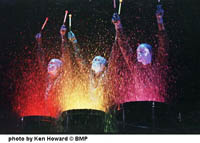 Right next door to
Right next door to 

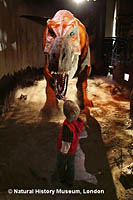 A couple of years ago, the Government decided that everyone should be able to take advantage of the wonderful museums that London has to offer; it made them all free. As a result, they are now more crowded, but as tourists, you won’t have the added expense of entry fees. My family particularly enjoys the Natural History Museum. As with all large museums, it’s best to pick a couple exhibits to see, other wise everyone is overwhelmed and the kids especially have a bad time.
A couple of years ago, the Government decided that everyone should be able to take advantage of the wonderful museums that London has to offer; it made them all free. As a result, they are now more crowded, but as tourists, you won’t have the added expense of entry fees. My family particularly enjoys the Natural History Museum. As with all large museums, it’s best to pick a couple exhibits to see, other wise everyone is overwhelmed and the kids especially have a bad time.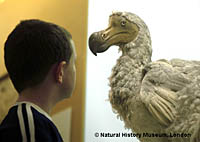 The Life Sciences section has huge fossils and dinosaur skeletons and a special exhibit in which they have a life-sized T-Rex which moves and roars. It’s a bit scary for very little children, so be warned. Other treats are rare stuffed birds, including a dodo. There are wonderful small and large fossils found along the southwest coast (named the Jurassic Coast) of England. The exhibit on Creepy Crawlies attracts kids of all ages back again and again.
The Life Sciences section has huge fossils and dinosaur skeletons and a special exhibit in which they have a life-sized T-Rex which moves and roars. It’s a bit scary for very little children, so be warned. Other treats are rare stuffed birds, including a dodo. There are wonderful small and large fossils found along the southwest coast (named the Jurassic Coast) of England. The exhibit on Creepy Crawlies attracts kids of all ages back again and again.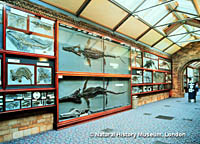 Our favorites are probably the fossils and dinosaurs and the area with the dioramas of prehistoric and modern animals. The huge fossils of prehistoric sea animals displayed on the walls are truly impressive. The smaller ones in the cases inspired us to go to Dorset and the Jurassic coast to look for more -which we indeed found!
Our favorites are probably the fossils and dinosaurs and the area with the dioramas of prehistoric and modern animals. The huge fossils of prehistoric sea animals displayed on the walls are truly impressive. The smaller ones in the cases inspired us to go to Dorset and the Jurassic coast to look for more -which we indeed found!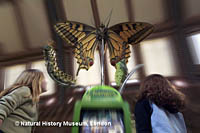 The Earth Sciences exhibits are reached up a long escalator in the main entry hall. You enter through a gallery of rare crystals in cases which are lit with black light to enhance the color
The Earth Sciences exhibits are reached up a long escalator in the main entry hall. You enter through a gallery of rare crystals in cases which are lit with black light to enhance the color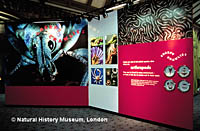 There is also a room fitted out as a small grocery shop in Kobe. Every couple of minutes, there is a recreation of what it would have been like to have been in the shop at the moment of the earthquake – initial tremours, then stronger and stronger shaking.
There is also a room fitted out as a small grocery shop in Kobe. Every couple of minutes, there is a recreation of what it would have been like to have been in the shop at the moment of the earthquake – initial tremours, then stronger and stronger shaking.